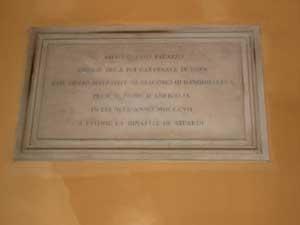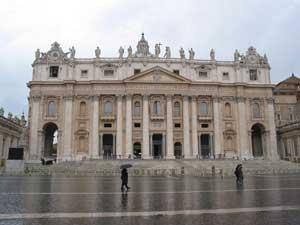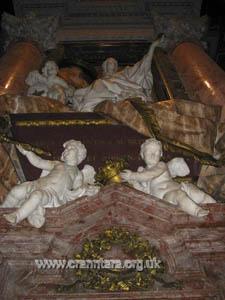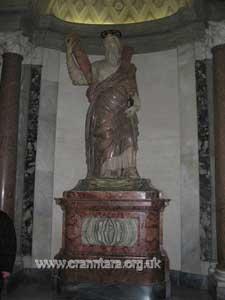| 7 till 10 - 01 - 2010
Crann Tara’s pilgrimage to Rome & Frascati |
Members of Crann Tara took a trip to Rome & Frascati in order to pay respects to members of the longest reigning Scottish royal family “The Stewarts”
The trip included visiting the places of interest where the family were concerned Frascati, The Piazza Muti, Church Saint Apostoli, The Scots College and Saint Peters to name a few. The trip was done over a long weekend in mid January done so because it marked mid way point between the dates Charles Edward Stewart was born on December 31st 1720 and when he died on 31st January 1788.
With the trip organised at a time when the country was a white out with snow the trip was in jeopardy of being cancelled due to the amount of the white stuff, but regardless the flight outward from Scotland was only slightly delayed due to frost freezing the moving parts on the wings a vast contrast to the few inches of snow which some how disabled our southern neighbours in England. Once in the sky it was great to see how the snow covered landscape projected an image of beauty particularly flying over the snow capped peaks of the Swiss Alps.
Landing in Rome we decided to visit Frascati first before heading to Rome so we jumped on a bus to Ciampino train station this only takes about 15 mins. On arrival you actually wonder if you are in the right place, when you consider the Airport is home to international flights the train station is nothing in comparison, it is more like a station you would find in the country. Frascati is only approximately another 15mins from the station in the opposite direction from Rome. As Frascati is located on a hill it is easy to see which direction you have to travel as the hill on which Frascati is based can easily be seen from the station platform.
|
Travelling to Frascati there is no mistake of when to get off as it is a nice little station, the last stop on the line. Remembering Frascati is on a hill this will come to your realisation when you have to climb the stairs to get you up to town centre. At the top of the stair the first thing you cant help to notice is the fabulous façade of the 16th century Villa Aldobrandini on the hillside in front of you with a avenue of trees which would have once been a grand entrance to the property. From the top of the stairs one has to go left to find the centre of the town, passing the street side cafes and up through a narrow shop lined street, the main plaza is only a couple of hundred yards away. On reaching the plazza the view opens up to expose the Cathederal of San Pietro Aposolo which towers over the plaza.
|
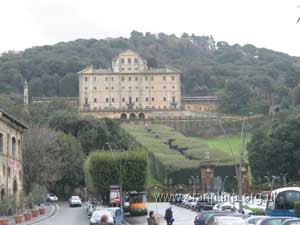
Villa Aldobrandini
|
| Once inside the main front door of the Cathedral you must veer to the left of the facade to see the impressive 6 -7 foot sepulchral marble stone memorial to the Stewarts [Stuarts], with coat of arms above. It was Henry that was responsible for the monument to his brother. Beneath the plaque was the initial burial place of Charles Edward when he died in 1788, the body of Charles was removed from this place to the Vatican 3 days after his brother Henry died in 1807, but his entrails remain here in a brass urn behind the plaque. |
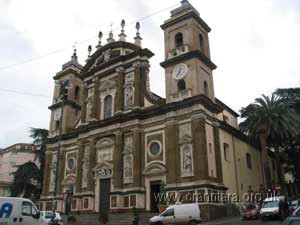
Cathederal of San Pietro Aposolo
|
The reason why Charles came about being in this church in the first place was down to his brother Henry’s relationship to Frascati. Henry became Cardinal Bishop of Frascati in 1761. He became Dean of the College of Cardinals in 1803, but continued to live in the Episcopal palace of Frascati until his death on 13 July 1807. He improved the town’s cultural life by founding the Seminary and library; it was here he was inaugurated to Cardinal.
In a back room here there is also a true life portrait of Henry signifying his relationship with the church. It was good to see that the church now has information boards which relate the history of the Cathedral and in particular the Stewarts.
Besides the San Pietro Aposolo it is well worth spending a couple of hours having a walk around the town, there is particularly a great view on a clear day from Frascati over the landscape full of vine yards towards Rome which is only about 20 kilometres away. |
fter heading into Rome and a brief visit to our hotel, we make our way to the Palazzo Muti this is where Charles Edward and Henry Stewart lived, Charles was born here in 1720 and where he also died in 1788 and where his brother Henry lived and died in 1809. The Palazzo Muti is just off the Via Quattro Novembre, which can be found at the bottom of the Via Nationale or from the other direction just off the Via del Corso.
Before reaching what remains of the Palazzo Muti we pass the Palazzo Colonna,The Palazzo Colonna is a palatial block of buildings in central Rome, Italy, at the base of the Quirinal Hill, and adjacent to the church of Santi Apostoli. It is built in part over ruins of an old Roman Serapeum, and has belonged to the prestigious Colonna family for over twenty generations. The first part of the palace dates from the XIII century, and tradition holds that the building hosted Dante in his visit to Rome.
Next to this is the Church of the Holy Apostles or known to us as the Santi Apostoli, this has the Scottish connection again related to the Stewarts.
This church is located on the east side of Piazza dei Santi Apostoli, immediately to the left of Palazzo Colonna. It was a bit of luck that we found the church open as opening times in Rome are usually normally open daily between 07.00-12.00 and 16.00-19.00, but on this occasion we were lucky there was a ceremony going on which included the inauguration of priests from the Pontifical North American College in Rome preparing men for the priesthood. Even though none of us were religious by any persuasion it was quite an impressive sight not just the sight of the ceremony being performed, but the inside of the church fully illuminated in all its glory with the numerous candles and chandeliers. We were assured by one of the priests that seeing this was a rare occasion since it was celebrating its 150th anniversary.
Anyhow, with the church open we took the chance to see what we had come to see. |

Marble stone memorial to the Stewarts |
It was the parish church of King James VIII/III when he lived in the nearby Palazzo Muti [now the Palazzo Belestra]. The body of Queen Clementina lay in state here before her funeral in the Basilica Di San Pietro. There is an engraving of the interior of the church as it appeared for
Clementina's funeral, it was engraved by Balthasar Gabbuggiani after a painting by Giovanni Paolo Pannini. In the Museo Di Roma is a painting of the same scene. Within the second pillar of the right (south) aisle a sepulchral tomb houses the preserved heart of Clementina Sobieska, wife of James VIII of Scotland. Her actual tomb is at San Pietro in Vaticano. Her monument is by Filippo della Valle. The Friars Minor Conventual, which is a branch of the order of Catholic Friars founded by Francis of Assisi in 1209, these priests and brothers who own the church, erected this monument in 1737. The face of the pillar is decorated with an ornate memorial, which incorporates two cherubs, the left one with a crown in his hand, the right one with a heart in his hand and hover around a large grey urn. Three more cherub heads hover above the urn. Below the monument is a porphyry tablet with a Latin inscription:
HIC CLEMENTINÆ REMANENT PRAECORDIA: NAM COR
CÆLESTIS FECIT NE SVPERESSET AMOR ·
MARIÆ CLEMENTINÆ
MAGN · BRITANN · ET C · REGINÆ
FRATRES MIN · CONV ·
VENERABVNDI PP ·
Here rest the praecordia of Clementina, for the heart
heavenly love did not allow to survive.
To Maria Clementina,
Queen of Great Britain, etc.
the Friars Minor Conventual
reverently placed this.
|
It was noted by the French historian Charles de Brosses in one of his letters,that James "spends each morning in prayer near the tomb of his wife in the Church of the Santi Apostoli".
James VIII/III was laid in state here himself in 1766, before he was buried at St Peter's beside his wife, Clementina died in 1735.
Henry, Cardinal Duke of York (later King Henry I/IX) was given this church for his cardinatial title, December 18, 1752. In 1758 he was ordained to the episcopate in this church by Pope Clement XIII. When he was transferred to the titular church of Santa Maria in Trastevere, February 12, 1759, Henry retained the title of Santi XII Apostoli in commendam until July 13, 1761.
In his will King James VIII/III had expressed his wish to be buried in this church, but Pope Clement XIII determined that his final resting place should be in the same church as his wife. On the evening of January 5, 1766, James' body was brought from the neighbouring Palazzo Muti (now Palazzo Balestra) and lay in state here for three days. The next day, Cardinal Giovanni Francesco Albani, Protector of Scotland, presided at the requiem mass, Pope Clement XIII being too unwell; Monsignor Orazio Mattei, Chancellor of the Basilica di Santa Maria Maggiore, gave the funeral oration. Then the body was taken in procession to the Basilica di San Pietro, where a second requiem mass was celebrated.
Managing to get a few pictures without disturbing the ceremony we made our way to the nearby Palazzo Muti the palace in Rome where the Stewarts [Stuarts ] resided. Although only a short walk form the Santi Apostoli it’s quite hard to imagine what it would have been like in the 18th century as the street now has numerous restaurants lining the pavement. As you get closer to the building itself though you begin to take in the reality of where you are unfortunately today apart from the façade of the building I doesn’t appear there is anything left of the original building. Looking back at old pictures from 1748 the façade doesn’t really seem like it has changed all that much, in fact the same can be said for the Santi Apostoli and the Palazzo Colonna as well.
This palace is located at the north end of Piazza dei Santi Apostoli. It was formerly called Palazzo Muti-Papazurri and sometimes Palazzo dei Santi Apostoli or Palazzo Stuart, now Palazzo Balestra. |

Portrait of Henry |
|
|
the inauguration of priests from the Pontifical North American College in Rome preparing men for the priesthood in the Santi Apostoli |
sepulchral tomb which houses the preserved heart of Clementina Sobieska |
|
plaque within the cobbled corridor of the Plazza Muti
|
Palazzo Balestra
This palace was only part of a series of buildings which was provided by Pope Clement XI to King James VIII/III in 1719 as his Roman residence. The palace was owned at that time by the Marchese Giovanni Battista Muti, nephew-in-law of Cardinal Pietro Marcellino Corradini. The annual rent was paid by the Apostolic Camera, an administrative department of the Holy See, the annual rent for the palace is debatable but it was claimed it was about 3000 scudi, which was approx 450 pounds sterling at the time. The palace rented for King James included not only that fronting on Piazza dei Santi Apostoli, but also two other palazzi and two houses adjoining it. One of the adjoining palaces is the Muti-Papazurri palace which fronts on Piazza della Pilotta and now houses the Pontificio Istituto Biblico, but it was in fact this palace which was the centre of the Stuart court.
King James VIII/III lived in this palace complex for over forty years. Here Queen Clementina gave birth to her sons: King Charles III December 31st 1720, and King Henry I/IX March 21st 1725. Queen Clementina died here January 18th 1735, and King James VIII/III January 1st 1766.
In 1766 Charles returned to Rome and used the palace as his main residence. After his marriage to Princess Louise of Stolberg he and his wife lived here until they moved to Florence in 1774. Charles returned to the palace in December 1785 and lived here with his daughter, Charlotte, Duchess of Albany. Charles died here January 30th/31st 1788. At Charles' death, the tenancy of the palace passed to his brother Henry, the Apostolic Camera continued to pay the rent.
Today some of the rooms still retains much of the decoration from the period of Stuart occupancy and can still be seen, particularly on the first floor rooms. In 1719 Pope Clement XI paid for the redecoration of the palace to prepare it for its new royal tenant. From 1628 to 1631 Charles Mellin had painted the vaults of the Galleria, the windows of which face directly onto Piazza Santi Apostoli. Giovanni Angelo Soccorsi restored the Mellin frescoes and added some of his own. One author has noted the presence among these frescoes of the "half moon heraldic symbol of the Stuarts", but this is based upon a misunderstanding.
|
There are two large doors facing onto the Piazza dei Santi Apostoli where the entrance to the palace was once upon a time, the doors are sometimes closed, but when open it leads you down a cobbled corridor then opens up to a court yard. The building today is full of separate apartments and offices. On the left wall of the corridor there is a plaque with an Italian inscription:
ABITO QUESTO PALAZZO
ENRICO DUCA POI CARDINALE DI YORK
CHE FIGLIO SUPERSTITE DI GIACOMO III D'INGHILTERRA
PRESE IL NOME D'ENRICO IX
IN LUI NELL' ANNO MDCCCVII
S'ESTINSE LA DINASTIA DE' STUARDI
There lived in this palace
Henry, Duke later Cardinal of York
who, surviving son of James III of England
took the name of Henry IX.
In him in the year 1807
the House of Stuart expired.
Its interesting to note that there is no reference to Charles Edward on the plaque, but it is like most of the plaques in Rome which give reference to the Stuarts, this is mainly down to the fact Henry was considered the more important of the two brothers because of his position in the Catholic church.
After having a look round the Plazza Muti we decided on getting something to eat, so knowing a wee Scottish themed pub a short distance away on the Via Quatro Novembre called the Nags Head we thought it appropriate. We also thought it fitting to have a toast to Stuarts who ended up here in Rome as well. Seeing a rather dusty bottle of Drambuie on the shelf asked the woman behind the bar if there was anything in it as it looked as though it had been on the shelf for a while. She took the bottle from the shelf and poured us a couple of drams, measures incomparable to that in Scotland. As she held the bottle in her hand we made her aware of the story of Drambuie from its origins to its connection to what was on their door step, its quite funny to think that Scots being in Rome could teach a Roman a piece of history in their own city. Happy with what we had seen, achieved and what we knew we had to do the next day we headed back to the hotel.
Up in the morning we had an appointment to meet Father John Hughes at the Scots College early. After introductions we were given a tour of the college beginning with its origins and history up until the present day, shown various artifacts and portraits relating to the Stuarts and finally the three original individual tomb stones of James, Charles and Henry from when they were each individually interred in the Vatican, these had been given the college sometime after 1925 when the three of them were put into the same crypt as it is seen today.
The Scots College
The Pontifical Scots College, Rome was founded on 5th December 1600 by Pope Clement VIII. It provided an education for young Scots Catholic men who, due to the laws against Catholics, could not receive a Catholic education at home. During the centuries that followed, the college sent a steady supply of priests to Scotland, being closed only when the French invaded Rome in 1798 and again during the Second World War. For two hundred years Jesuits and Italian secular clergy directed the College, but since 1800 the Rectors have all been Scots secular priests.
At first the college was sited in a little house in what is known today as Via del Tritone, opposite the church of S. Maria in Costantinopoli. In 1604 it was transferred to Via Felice, now called Via delle Quattro Fontane, and there it remained till 1962. The Church of St. Andrew of the Scots was built beside the college and, although no longer in the possession of the college, Mass is still regularly celebrated there. The present college building on the Via Cassia was opened in 1964 by Pope Paul VI and has since been visited by Pope John Paul II. |
 |
| |
Scots College Coat of Arms |
|
|
The tomb stone of James |
The tomb stone of Henry |
|
As well as a house for students for the priesthood, the Scots College has been a temporary home for many other Scots, such as the Bishops during the Second Vatican Council and other meetings, the several groups of priests who have taken part in theology refresher courses and, more recently, groups of pilgrims who come during the summer vacation. It has been at the centre of celebrations for the creation of three Scots Cardinals, Cardinal Gray, Cardinal Winning and Cardinal O'Brien, and it was visited by many pilgrims who came from Scotland for the Canonisation of St John Ogilvie.
The Pontificio Collegio Scozzese was formerly located at Via delle Quattro Fontane 161 immediately opposite Palazzo Barberini. The college was rebuilt in 1869 when the present facade was erected. Above the first floor window over the main entrance is a carving of the Royal Arms of Scotland with supporters and the motto "NEMO ME IMPUNE IACESSIT" (No one injures me with impunity).
Above the windows of the top floor are six front-facing deep relief busts in round niches, each representing an important person in the history of the college. The second of these busts from the left is of King Henry IX and I in the circle around the bust is a Latin inscription:
HENRICVS CARD DVX EBORACAE
Henry, Cardinal Duke of York
The building is now owned by a bank, CARIPLO (Cassa di Risparmio delle Provincie Lombarde).
Since 1964 the Pontifical Scots College has been located several miles northwest of central Rome at Via Cassia, 481; the College was formerly located at Via delle Quattro Fontane 161.
The college have on display a number of items of Stuart interest, from copies of Stuart portraits, an oil portrait of King Henry IX and I attributed to Joshua Reynolds, a large copy of a 1774 engraving of Saint Peter's Basilica and Square with an engraving at the bottom dedicated to the Cardinal Duke of York with his coat-of-arms and a proclamation of the Prince Regent later King Charles III, dated October 10, 1745.
In the crypt of the chapel are preserved the original tombstones of King James III and VIII, King Charles III, and King Henry IX and I. Until 1938 these stood in the crypt of the Basilica di San Pietro in Vaticano.
|
The tombstones of James, Charles and Henry are inscribed in Latin as below, the inscriptions stipulate their positions from the British crown point of view obviously relating to their regal position at the time.
King James III and VIII
IACOBVS III.
MAGNAE BRITTANIAE, SCOTIAE, FRANCIAE, ET HYBERNIAE
REX
VIXIT ANNOS LXXVII. MENSES VI
DIES XI
OBYT KOL IANVARY MDCCLXVI
James III,
King
of Great Britain, Scotland, France, and Ireland.
He lived 77 years, six months,
[and] nine days.
King Charles III
D · O · M ·
CAROLVS III ·
IACOBI III · MAGNÆ BRITTANIÆ
FRANC · ET HIB · REGIS FILIVS
NATVS MDCCXX ·
OBIIT PRID · KAL · FEBRVAR ·
MDCCLXXXVIII
To God, most good, most great.
Charles III
son of James III, King
of Great Britain, France, and Ireland,
born 1720,
King Henry IX and I
D · O · M ·
HENRICVS IX ·
IACOBI III MAGNÆ BRITTANIÆ
FRANC · ET HIB · REGIS FILIVS
DVX EBORACENSIS NVNCVP ·
EPVS OSTIEN · ET VELITERN ·
S · R · E · VICE CANCELLAR · S · COLL · DECANVS
SS · BASILICÆ VATICAN · ARCHIPR ·
TVSCVLI OBIIT DIE XIII · IVL · AN · MDCCCVII ·
VIXIT · AN · LXXXII · M · IV · D · VII ·
To God, most good, most great.
Henry IX,
son of James III, King
of Great Britain, France, and Ireland,
called Duke of York,
Bishop of Ostia and Velletri,
Vice-Chancellor of the Holy Roman Church, Dean of the Sacred College of Cardinals,
Archpriest of the Most Holy Vatican Basilica,
died at Frascati, July 13, 1807.He lived 82 years, four months, [and] seven days.
|
|
|
The tomb stone of Charles
|
proclomation made by Charles III dated October 10th 1745 |
After being given the tour of the college, taking numerous pictures of the collection and learning of its history from past to present, we thanked Father John Hughes for his time before saying our good byes then we headed to our final destination of our pilgrimage, The Vatican.
Being mid January the concourse in front of San Pietro was relatively empty in comparison to that of the summer months as was the queues into the Vatican itself.
If you have never been inside the Vatican, well you are completely blown away by what you see and feel as soon as you enter the Basilica. The sheer scale of the building and the architecture within it creates an atmosphere like no other regardless of being religious or not, in fact it has the largest interior of any Christian church in the world holding 60,000 people.
The place to visit for us with the Basilica was the Antonio Canova monument to the Stuarts, on entering the main door you must head to the left to the south aisle and it can be found back to back with Saint Peter of Alcantara and St Lucy Filipini.
The Canova monument was first commissioned in 1810 a year after Henry’s death by Monsignor Angelo Cesarini, executor of the estate of King Henry. The responsibility was relied upon Antonio Canova to design a worthy monument to Henry's memory with a price of 9,000 Roman scudi being agreed upon approximately 1350 pounds sterling, but it seems that not all of this was paid. Canova prepared a first design for the monument which is now in the Biblioteca Nazionale di Firenze. A second design is in the Museo Civico di Bassano, but then project for the monument, some how lost inspiration.
In 1815 Canova was in London at the same time as King Henry's protegé Cardinal Ercole Consalvi, with a mutual interest in the Stuart monument this had obviously lead to it being discussed which eventually resulted in the Hereditary Prince of Hanover who called himself "Prince Regent" and later "George IV" granting Canova 50 pounds to complete the project. With this renewed financial backing for the project now certain, a change was made to include James III and VIII and Charles III in the monument as well. Canova prepared a third design for which there is a terracotta model in the Gipsoteca di Possagno. The fact that the monument was originally intended chiefly to honour Henry IX and I is shown by the central position that his portrait has in the final work. In 1819 the completed monument was installed in the basilica.
The monument is in line with the underlying tomb in the Vatican Grottoes. The small fronton on top is embellished with a carving of the Stuart coat of arms of two lions rampant. On the lower part, in front of a closed door, symbol of the old unfortunate dynasty stand two angels whose incomparable beauty blends with their pain. The folded wings and bowed heads express resigned sadness over the mystery of death. All this sadness, however, is dissipated by
the comforting words of the bible over the closed door "Happy are those who fall asleep in the Lord".
George III, king of England (1738-1820) wanted to forget all monarchical and dynastic rivalry, so he generously financed the cost of this monument. |
|
A portrait of Saint Andrew |
The Latin inscription on the monument
IACOBO III
IACOBI II MAGNAE BRIT REGIS FILIO
KAROLO EDVARDO
ET HENRICO DECANO PATRVM CARDINALIVM
IACOBI III FILIIS
REGIAE STIRPIS STVARDI POSTREMIS
ANNO M DCCC XIX
To James III,
son of James II, King of Great Britain,
to Charles Edward,
and to Henry, Dean of the Cardinal Fathers,
sons of James III,
the last of the Royal House of Stuart,
1819.
On the lintel above the sculpted door on the tomb is a quotation from the Book of Revelation 14:13:
BEATI MORTVI
QVI IN DOMINO MORIVNTVR
Blessed are the dead
who die in the Lord.
If you turn 180 degrees from the Canova monument and look up above the archway directly opposite you come face to face with a monument to Maria Clementina Sobieski, (1702-1735). The monument to Clementina is only one of 3 women who are honored in the Basilica a rare honour indeed of burial in St. Peter's normally reserved for popes and saints, the monument was completed in December 1742. Clementina was the niece to the King John II of Poland who married James Stuart, James III in 1719. She looks down from her monument to that of her husband and sons. At the age of 33, she died of tuberculosis and was buried in St. Peter's. The princess is portrayed in a medallion held up by a cherub and by the statue representing Charity, the work of Pietro Bracci (1700-1773) and designed by Filippo Barigioni. At her death in 1735, the body of Queen Clementina was placed in the crypt. In 1745, however, it was moved near to her monument at the base of the staircase to the cupola. A Latin inscription marks the spot:
CORPVS
MARIAE CLEMENTINAE MAGNAE BRITANNIAE REGINAE
XV. KAL. FEBRVAR. MDCCXXXV
AETATIS SVAE XXXIII. ET. MENS. VI. DEFVNCTAE
IN HVIVS BASILICAE CRYPTIS POSITVM
HVC DIE XXII. MENSIS IANVARII ANNO MDCCXLV
TRANSLATVM ET RECONDITVM EST
Moving down the centre isle towards the dome and the Confessio [ The tomb of Saint Peter]there is the old entrance to the Grottoes entering the south east pier there is a small room this is where we a fabulous 4.68 metre high marble statue of Saint Andrew can be found. This statue by Francois Duquesnoy was unveiled before Urban VIII on 2nd March 1640. It was the first out of the four statues in the piers to be started. The saint is standing dynamically in front of a characteristic cross, watching the sky in ecstasy and is one of the best statues of Saint Andrew to be seen.
Finally there is only one more thing to see and pay respects to and that is the sarcophagus of James, Charles and Henry in the crypt of the Vatican.
To find this one must make there way back out the main door and follow the building round to the right, the entrance to the crypt is easy recognisable and a tourist route to follow is in place with new information display stands beside each sarcophagus. The Stuart tomb can be found on the left aisle, between the tombs of Cardinal Merry del Val and Pope Innocent XIII.
Finding the sarcophagus we dutifully paid our respects to all within regardless of the public presence where it was once behind gates and more private affair.
The sarcophagus in the Vatican crypt is the final resting place of, first of all, James VIII/III, who died in 1766 in Rome, where he had lived under the papal protection. His two sons are buried in the same tomb all three in exile in Italy. Charles Edward, after his death in Rome in 1788, but he was first was buried in Frascati, where his brother Cardinal Henry Benedict, the Duke of York, was Bishop. The latter, who for more than 57 years was the Archpriest of the Vatican basilica, was buried close to his father in 1807. Later, the remains of his brother were brought here. In 1938, Pope Pius XI granted the request of Cardinal Eugenio Pacelli, who was then the Archpriest of St Peter's, to build a single, more dignified tomb for the three of them, who were already commemorated by the monument built in the basilica by Canova in 1819. On August 8, their remains were exhumed and located in a provisional loculus. In 1939, they were given definitive burial in the new sarcophagus among the other late ancient tombs. It sits on a slightly larger base and the barrel lid is decorated with two sculpted laurel wreaths with inscribed crosses. On the top, in the center is a bronze sculpture of crown sitting on a cushion. On the front is the following inscription.
IACOBO III
IACOBO II MAGNAE BRIT. REGIS FILIO
CAROLO EDVARDO
HENRICO DECANO PATRVM CARDINALIVM
IACOBO III FILIIS
REGIAE STIRPIS STVARDIAE POSTREMIS
To James III
son of James II, King of Great Britain
to Charles Edward
and to Henry, Dean of the Cardinal Fathers
sons of James III
the last of the Royal House of Stuart
|
|
Stuart sarcophagus in the Crypt of the Vatican |
Saint Pietro [The Vatican ]
|
|
|
The Antonio Canova monument to the Stuarts |
The monument to Maria Clementina Sobieski |
A special thanks to Father John Hughes for his time, giving us a most interesting tour of the Scots College and sharing his wealth of knowledge with us.
|
Back to Top
|


